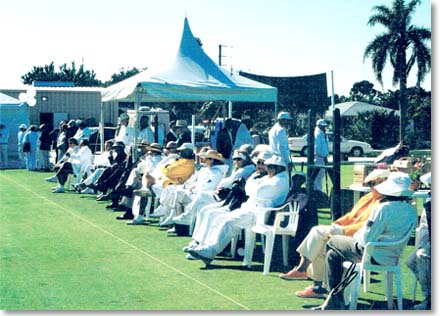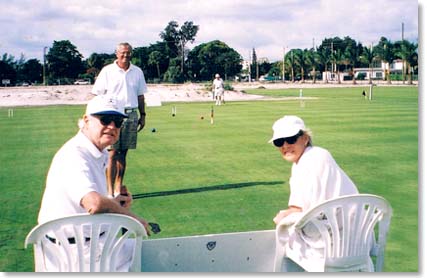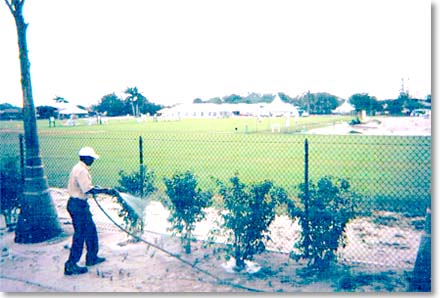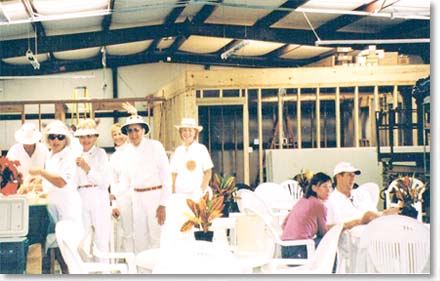

|
Back to |
| The Front Page |
| People |
|
Part Four: The Alman Memoir Organizing the Florida Center |
||||||||||||||
|
by Bob Alman
|
||||||||||||||
|
||||||||||||||
Bob had written the following in 2001 at the end of an article on the San Francisco Open, which for a time was the strongest players' tournament in the United States: "The new frontier of American croquet is no longer way out west; oddly, it has moved back East, back to Florida, back to West Palm Beach. All the experimentation and innovation we did in the West will be multiplied ten times over at the National Croquet Center. The modest San Francisco experiments in public court programs will be duplicated and expanded at a national center which will provide lawns not only for the country's finest resort-class club, but also for public and corporate groups, to provide as many workable models as possible for marketing the sport more broadly throughout the Americas."
The great expectations of Bob and Chuck Steuber were never to be realized. They didn't know they had only a short while to attempt to duplicate in Florida the range and vitality of "public court croquet." They didn't know, nor did anyone, that after Chuck's exit, the East Coast Croquet Establishment would delete, one by one, all the programs Bob designed to grow the sport in America to the level envisioned by the USCA's founder, which Jack Osborn explicitly announced: 100,000 members of the USCA by 2020.

|
| The National Croquet Center was in full operation in 2001 before the clubhouse was begun. Here the seated spectators are watching a club event on Court Four, with perhaps others viewing from the Festival tent on the far left, where meals were served, with everything managed from the Maintenance Shed in the background. The gazebos have yet to be constructed. The car is headed to the temporary parking area just east of the irrigation pond, always jammed during club events. |
It wasn't their fault, of course. Naturally they would nix anything that didn't match what they already knew how to do: they thought it was their job to imitate their own private clubs. But let's not get ahead of ourselves.
Shortly after Bob had heard, in the late 90's, that a wealthy Floridian had purchased 10 acres in West Palm Beach to build a national headquarters for croquet in America, he emailed Chuck Steuber and arranged to fly out to meet him at Testa's, in Palm Beach, for lunch.
As it turned out, Steuber had been invited to join the Croquet Foundation of America's board, which encourages members to make a significant contribution, either in work or monetary contributions. Steuber had quickly decided that his contribution was to be the financing an exceptional "center" for croquet in America, unlike any other in the world. Which made him an excellent choice for President of the CFA board.
Their meeting was in Palm Beach on a non-humid day in the spring of 1999, as Bob remembers it. They chose to sit in a shaded spot on Testa's patio, alone. Chuck told Bob how impressed he was with Bob's three-volume Monograph Series on Club-Building (published by the CFA and still available for purchase.) They talked about how much of the Monograph content could be actualized in large scale at a facility that would actually reflect the best of two worlds: the elegant nature of what Jack Osborn called "a game for the elite class" and a venue open to the public, with modest membership dues closer to the cost of clubs on public turf than were typical of country clubs.

|
| USCA Office Manager Shereen Hayes and her staff shows a delighted Chuck Steuber the cake they brought for the "soft opening" for members on December 7, 2000. Shereen would heroically accommodate the staff and equipment at her commodious house out west in Loxahatchee for a few months in 2001 to allow time for their offices in the Maintenance Shed to be completed. |
They started to work out, between them and with the input of Archie Peck, a "curriculum" for the Center that would cover the entire spectrum of "amateur" to "croquet pro" starting with a free Introduction to Croquet every Saturday morning. Full membership, they decided, would cost $1,000 for a year, and many other types of membership would offer playing privileges limited by some combination of court size, allowed playing times, or type of croquet game played. The overall program would be in constant flux, with prices and privileges adjusted to adapt to rapid growth.
Membership dues and privileges would be fluid
Theoretically, everyone would be able to afford to join at some level, with the price pegged to what privileges they would have. All the members would have full "social" privileges, but only "full members" at the highest rate would have access to full courts all the time, for any kind of croquet they wanted to play. Bob and Chuck agreed on the impressively large and beautiful center's publicity potential: stories in local and national media which would show how croquet had become, indeed, a fast-growing sport.
Having reached an accord on what the nature and purpose of the facility would be, Chuck engaged Bob in the explicit design of the curriculum, including detailed descriptions of how each part would work, and how it would all work together and succeed because it left nothing out, connecting a coordinated purpose in a comprehensive program that would maximize the sport's potential by attracting more players and more KINDS of players--including younger people and corporate people--but still lean towards the broader portion of the demographic called the "upper middle class."

|
| John Curington (standing and smiling) stayed on as the Project Manager for everything built on the site after his crew finished constructing the courts. |
Chuck told Bob he was going to send every member of the Croquet Foundation if America all three volumes of the Monograph Series, and use it as background and basis for the board's evaluation of all the proposed parts of the "curriculum." He did that, the following month.
Bob asked about the building site and was told that the ten acres had long been a nursery, and that it was soon to be cleared of all the plantings while the overall design of the project was completed with the architect. The architect he engaged was Digby Bridges, known in the region as "architect for the rich."
Because Bob was also engaged in building the USCA website he had created in 1996, which he managed thereafter for seven years, he visited West Palm Beach several times in the late nineties. On one of these visits, he asked the workmen struggling with a fully-grown Acacia Palm why they were removing it, and one of them said, "Because it's not on the plan," pointing out the entire schema for planting. Bob found a place for the Acacia between Court Two and the irrigation pond, where it would provide shade for players. It also shades a sculpture of Alice donated by Howard Sosin.
On Bob's suggestion, Chuck had engaged John Curington to build all twelve lawns, according to Digby's overall design. Curington was soon at work on the property, with the three-man crew he brought down from his native Jacksonville, in early 2000. Curington--an experienced contractor in Jacksonville--was on hand as Project Manager for the building when the lawns were officially opened on December 7, 2000. There was a party, which included a Curington barbecue. Chuck Steuber was delighted. The USCA staff was delighted. The members were delighted. Everyone was delighted.
It was to be a "new birth" for American croquet
| Hiring and housing the staff |
|
The staff office in the northeast corner of the Maintenance Shed was just big enough for Archie Peck, Bob Alman, and a Membership Director. Bob interviewed many people for the Membership Director job and chose Jan Warrington, who had taken an early retirement from a customer service job with Delta Airlines. She was bright and clever and came with a half-chuckle laugh that irritated Archie. Archie's smoke irritated all of them, so a deal was struck: Archie would smoke ONLY outside the office, and Jan would try to suppress her laugh inside. The USCA staff was not onsite until the spring of 2001, because the lease at Palm Beach Polo expired at the beginning of the year, so office manager Shereen Hayes heroically accommodated the staff at her commodious house out west in Loxahatchee, to allow time for their offices in the Maintenance Shed to be completed. But Shereen and the USCA staff nevertheless helped Bob and John Curington arrange the "soft opening" party for members on December 7, 2000.
|
The Maintenance Shed was big enough to support the event, and Bob had bought the courtside Festival Tent for shelter and food service, abutting Court Four. Visitors would tell us that the Center already competed favorably as a playing venue with most other croquet venues in the world. We organized everything out of the huge Maintenance Shed, with the USCA offices in one corner, our management office in another corner, restrooms, a big "party space" in the middle, and plenty of room left over for equipment and storage.

|
| Briefly, the Center was "exposed" to the public, and everyone was invited to see it. The clubhouse had not started construction yet, delayed by delays in numerous permits. And the concealing hedges were not yet grown. |
With "expert" guidance by Palm Beach croquet socialites--who seriously evaluated each candidate based on both the food and the service in the Festival Tent, big enough for catered breakfasts and lunches--Joe Dillon's Carefree Catering was chosen as resident caterer. He had a separate food preparation facility not far away, and would prepare meals on-site for the Center's own dining service when the building opened.
Everything worked perfectly......at first
Chuck was the perfect boss, combining all the cash with all the authority, some special contacts of his own, and a refreshing confidence in the abilities of the people he hired to do their jobs: Bob, Director of Croquet Archie Peck, Project Manager John Curington, Joe Dillon and Carefree Catering; and Digby Bridges, "architect of the rich" and builder of the National Croquet Center finally rising on its foundations on the west side of the 10-acre property.
| Four overseas groups visited in 2001 and 2002 |
|
To help publicize the opening of an "international showcase" for the sport, Bob Alman negotiated four incoming foreign groups to visit before the clubhouse was completed: two groups from Britain and two editions of an International Festival of Croquet. Bob handled the incoming travel arrangements, taking into account the English love of "walk-around" locations. Their Lake Worth hotel allowed the participants to walk east from their hotel on the Intracoastal to downtown Lake Worth or west across the bridge to the Atlantic beach. They visited other croquet clubs in the area in their bus, including PGA National and a club in Boca Raton. The events at the other clubs were managed by a volunteer Bob had recruited at each club (The South Florida Host Committee) and were billed as "Croquet the English way" featuring double-banked American doubles after Association doubles, with the foreign guests each partnered with a local host player.
|
He recalls his surprise when an acquaintance in Australia asked bluntly via email, "What' s going on over there, Bob?" He was referring to a blind copy of a scathing criticism of Bob's management. The facts in it were mostly untrue or incomplete. But it was a jolt. An "internal memo of the USCA blind-copied to croquet players around the world? Very odd. Bob thanked his Australian friend and prepared to defend himself as well as he could from what he felt were unjustified attacks, via second-hand side-swipes.

|
| The "soft opening" for members on December 7 was a joyous affair. The Maintenance shed, though cluttered, was used for the first time as a social space. The USCA offices are being built in the background. |
It wasn't entirely unreasonable at the time to imagine that the Center would ultimately be managed by the USCA. The large and gorgeous clubhouse was being constructed, after all, as the national headquarters of the USCA and all the American organizations that support the sport. So why wouldn't it be managed by the organization? Because, Bob answered himself, it was the East Coast Croquet Establishment which had hobbled the growth of the organization to only about 3,000 members; and Chuck wanted to expand the range of croquet beyond Jack Osborn's perfectly legitimate blueprint for establishing the sport of croquet in America by pitching it initially to "the elite class."
Strange signals of sabotage
As the number of blind-copy attack continued, Bob told Chuck about it, going over with him the specifics of some of the blind-copies, and asked him what to do. Most of the time, Chuck endorsed what Bob was doing to address one issue or another. Once in a while, Chuck was so upset he wrote Bob a letter to avoid confrontation; invariably it turned out to be a matter which had been totally misrepresented to Chuck, and easily cleared up. Bob and Chuck, finally, would always agree on the correct course. And Bob would persist until he achieved the result. Of course. The partnership was profoundly satisfying to Bob, as it seemed to be to Chuck as well.
Chuck's response to the apparently mean-spirited blind copying by the president of the USCA was, "Don't worry about it, Bob. I'll take care of him. He's strictly second-rate."
So Bob continued to carry out all his promotional plans for the Center, which included three-page photo-spreads in both local dailies, a full schedule of speaking before Rotaries and Chambers of Commerce, special contacts with the Palm Beach County Sports Commission and the school district, and free programs for school children in the "dry retention area" on the east side of the facility that Bob had requested planted with grass short enough for the playing of casual croquet and multi-sports.
Most important, to Bob, were the unique programs and events he would produce after the clubhouse was open to genuinely expand the sport's reach, beyond the majority of mostly elderly people, into a "corporate-age" demographic, with a program he called the Five-to-Nine-Club--a club within a club exclusively for young working people, with convenient after-work hours.
He intended as well to institute a limited, half-court Golf Croquet membership with only two playing times a week, slightly off-peak hours, also after the clubhouse was opened.
But one fall day in 2001, disturbing news came to the management office in the Maintenance Building: Chuck Steuber had suffered a stroke, and it appeared to be severely debilitating.
Suddenly, a lot of things would change. The consequences would be radical. Many of those consequences will be described in Part FIVE of this memoir.
|
NCC event calendar, spring of 2002
The county Zoning Commission did not allowed the Center to be open for play, except for special events, in the spring of 2002, largely because all the parking had to be done onsite, via a neighborhood street, and the neighbors had complained in 2001. Consequently many 2001 activities were packed into one six-week period, all by permits. NCC membership numbered less than a hundred at the time, mostly composed of "the 2001 Club," people who donated $1,000 and paid an equal amount for club membership. The first edition of the International Croquet Festival had drawn players from all around the world in 2001. The second (and final, as it turned out) festival started with viewing the finals of the Golf Croquet World Championship, from the elevated veranda of the unfinished building. This verbatim excerpt from CroquetWorld's Bulletin Board, demonstrates the range of possibilities which were never completely realized when the Center actually opened, because....
Jan 8-9 - USCA Breakplay School |
|
From Croquet World's online Bulletin Board |
This croquet memoir is being published as a multi-part series. The first four parts are already published here in CroquetWorld.com. Bob Alman was named to the World Croquet Federation's Hall of Fame in 2020. He has politely declined induction into the Croquet Foundation of America's Hall of Fame, which, however, has accepted this magazine as a gift to be maintained online ongoingly as a legacy site by grants and Bob's estate.